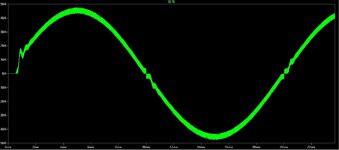cupoftea
Advanced Member level 5
Hi,
We are making a 32Arms sine source (50Hz). .using a 40khz switching bridge. Its simply to shovel 32Arms through the conductors of a mains distribution box so as to high current test it.
We wish to use a kool mu torroid inductor in the switching bridge.
It is Mag inc part number 77907A7, and will be approx 31uH at peak current (45A).
Mag inc part number 77907A7 datasheet:
We want to work out the peak B (so we can check it wont saturate) and the delta B, (so we can calculate core losses).
The 77907A7 datasheet only gives a graph of AL vs NI.
To get the “B vs Current curve”, we have done as in the attached excel.
Basically, we have taken the graph as being piecewise linear and considered three linear sections, with the three gradients. Thus we get the "equation" for the graph, as in the excel attached.
We end up calculating the ur from the AL value. We then get the uo.ur value for each current value. uo.ur is the gradient of dB/dH....so we actually calculate the dB/dH at each value of H, and thus gradually build up the B curve, as it accumulates upwards as the current increases.....in the end , we dont even end up plotting the graph, but just get the table of values, which suffices well enough for the purpose.
At the peak current of 47.5A , we calculate a peak B of 0.357T.
Would you say this sounds right?
We also calculate a delta B of just 26mT at the peak of the sine, which seems very low?
Is it correct? Is this the right way to go about the calculation?
We are making a 32Arms sine source (50Hz). .using a 40khz switching bridge. Its simply to shovel 32Arms through the conductors of a mains distribution box so as to high current test it.
We wish to use a kool mu torroid inductor in the switching bridge.
It is Mag inc part number 77907A7, and will be approx 31uH at peak current (45A).
Mag inc part number 77907A7 datasheet:
We want to work out the peak B (so we can check it wont saturate) and the delta B, (so we can calculate core losses).
The 77907A7 datasheet only gives a graph of AL vs NI.
To get the “B vs Current curve”, we have done as in the attached excel.
Basically, we have taken the graph as being piecewise linear and considered three linear sections, with the three gradients. Thus we get the "equation" for the graph, as in the excel attached.
We end up calculating the ur from the AL value. We then get the uo.ur value for each current value. uo.ur is the gradient of dB/dH....so we actually calculate the dB/dH at each value of H, and thus gradually build up the B curve, as it accumulates upwards as the current increases.....in the end , we dont even end up plotting the graph, but just get the table of values, which suffices well enough for the purpose.
At the peak current of 47.5A , we calculate a peak B of 0.357T.
Would you say this sounds right?
We also calculate a delta B of just 26mT at the peak of the sine, which seems very low?
Is it correct? Is this the right way to go about the calculation?
